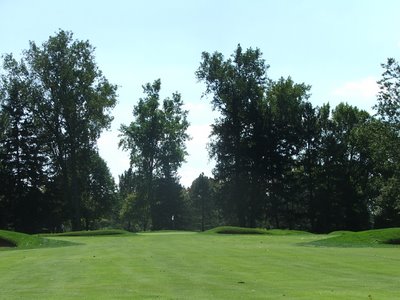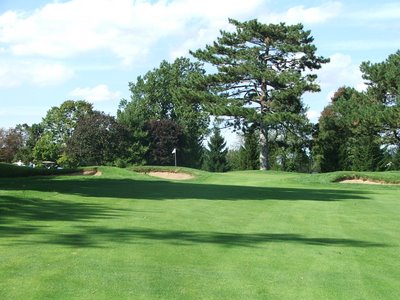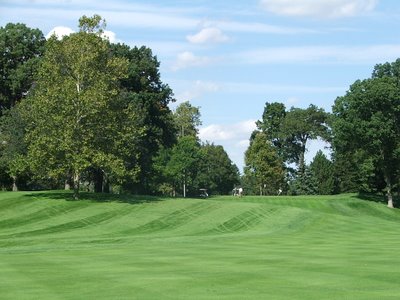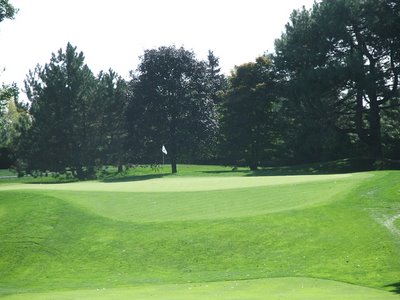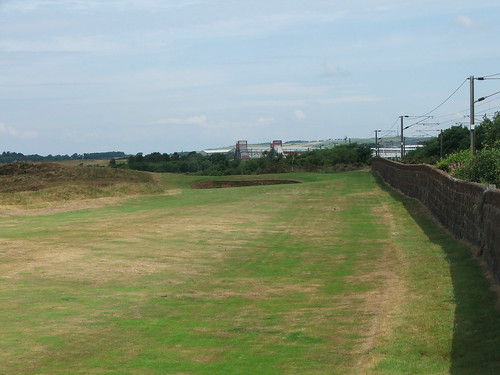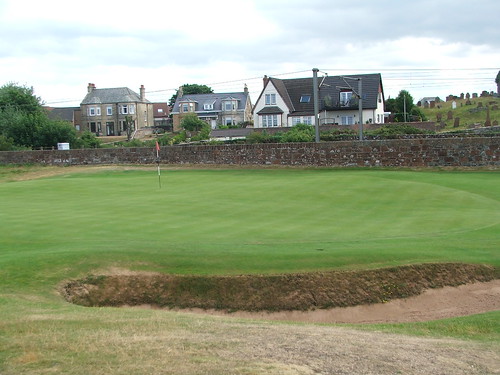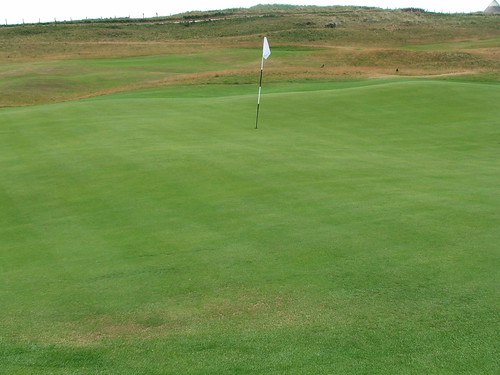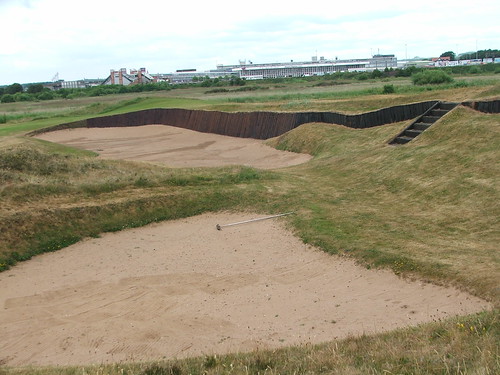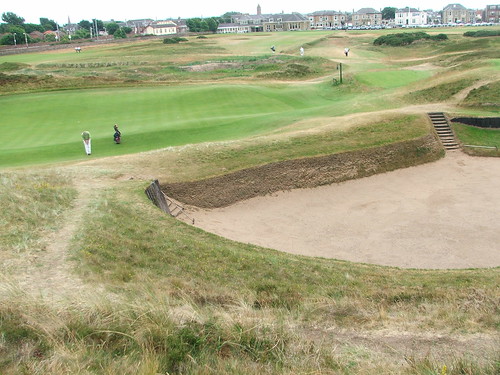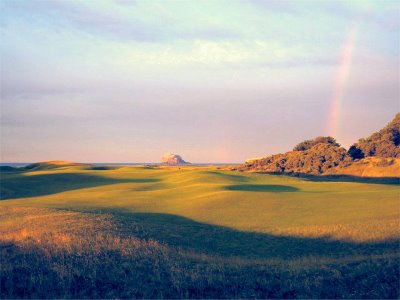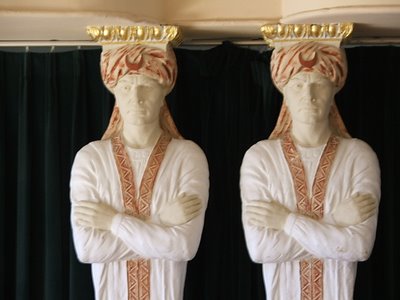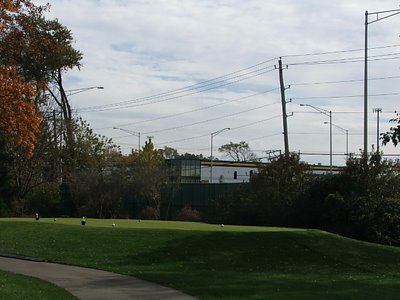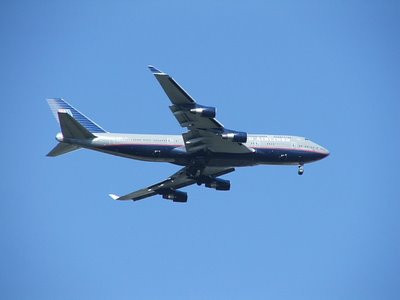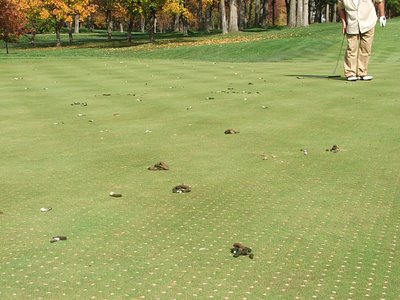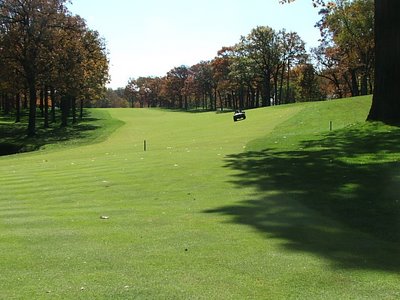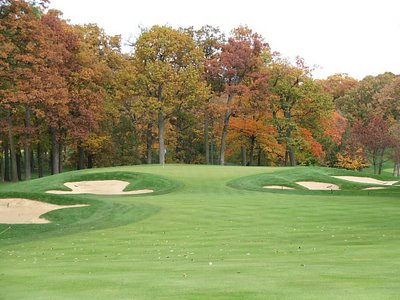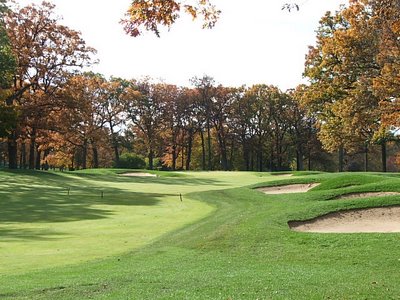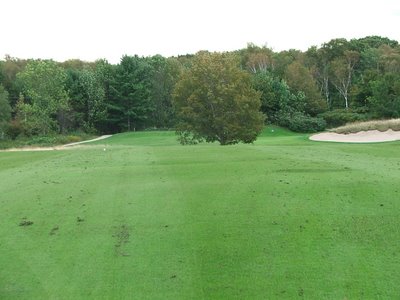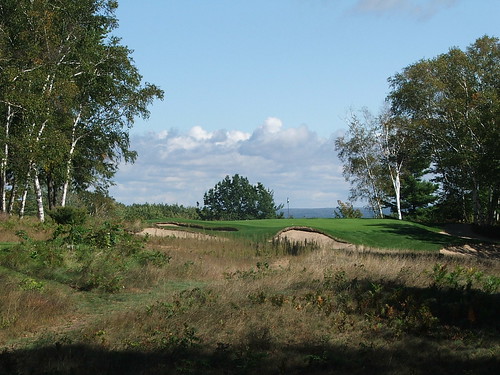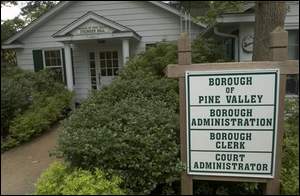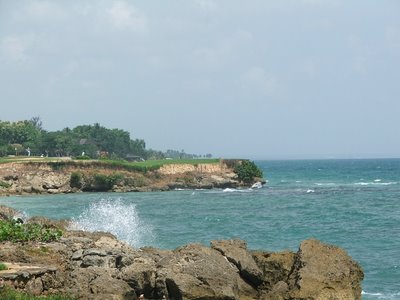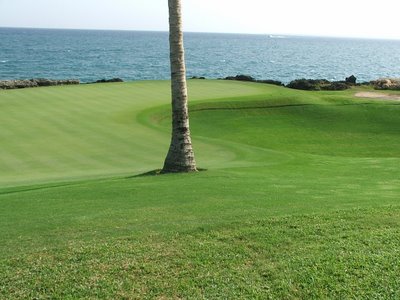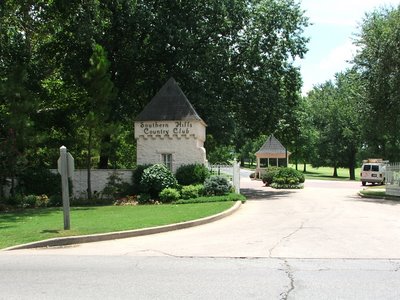
What do Prairie Dunes Country Club (ranked #23 in the world) and Southern Hills Country Club (ranked #41 in the world) have in common? Both were designed by Perry Maxwell during the depression era and both are located in the dust bowl region of the United States. Prairie Dunes in the flatlands of Kansas and Southern Hills in Tulsa Oklahoma. Maxwell must have been at the height of his creative genius in 1935, when both were built.
Perry Maxwell
Maxwell was a Princeton graduate and banker turned golf course architect. I had the opportunity to play both courses on a recent trip out West. I hadn't previously known who Perry Maxwell was. It turns out that not only did he design Prairie Dunes and Southern Hills but he also was called in to do green renovations at Pine Valley and Augusta National among other courses. For a time, he teamed up with Alister Mackenzie and worked on Crystal Downs (ranked #24 in the world). Not bad, for someone who is not generally well known in the world of golf course architecture. Maxwell's signature is his green design - generally small greens with severe undulations that are quite difficult.
Southern Hills
Southern Hills is an ultra-private club guarded by an entrance gate with a sentry. Reminiscent of a half dozen other courses I have played (Los Angeles, Riviera, Sunningdale, Muirfield) you have to be cleared by the guard before they will raise the gate and let you in. Southern Hills has a large membership with 960 members, and a locker room befitting such a fine course. A repeated host to major championships (three US Opens and three PGA championships), the club has a feeling of grandeur to it. The club house is located at the top of a winding, tree lined driveway set up on a hill. At the top of the hill you overlook the golf course below and the skyline of Tulsa. The first thing that strikes you about Southern Hills is (duh?) the hills. While you are in essentially flat country, the land the course was developed on is quite hilly. For anyone who has ever been to Augusta, the first thing that strikes you is that the course has much more elevation change than you can see on television or in pictures. I had the same feeling here; you really can't see the big elevation changes until you are there first hand.
Some golf course designers believe in the philosophy of starting easy and getting progressively more difficult as the course goes along. Perry Maxwell apparently had the opposite philosophy, at least at Southern Hills. The course hammers you right out of the gate. The first three holes are handicap 3, 1 and 7, respectively. I would say that Maxwell deserves the high praise he has received as a designer. The course is very interesting. Almost every par four or five is a dogleg, sometimes severely so. He used the land to imaginatively route the course with great variety. As an example, the fine stretch of holes 10-12 are pretty typical of what you can expect.
The tenth hole plays from an elevated tee box down a big hill. At the bottom of the hill the hole sharply doglegs to the right and plays to an uphill, well bunkered green. The 11th hole is a downhill par three, heavily bunkered and with a typically small green. The 12th hole plays slightly uphill on the tee shot and sharply downhill on the second and doglegs sharply to the left. This seemed to the essence of the layout: a variety of holes with interesting doglegs playing both up and downhill with small greens that have both overt and subtle breaks.
Most holes at Southern Hills are tree lined and my guess is that the members have perfected the punch shot -- to hit out from under trees and bounce the ball toward the green. Our group played this shot a lot during our round there. One of the illusions that Maxwell was successful at pulling off here is that the fairways actually look wider from the tees than they actually are. Even if you hit the fairway, if you are not on the correct side of it, often times your ball will roll off due to the slopes. Unless you are in the fairway at Southern Hills, and also on the correct side of the fairway, you will find that you probably don't have a clear shot at the green without some branches coming into play.
I played Southern Hills on a 100 degree August day with a moderate warm wind. It was so hot that I broke down and took a golf cart which regular readers know is anathema to me, but was the right decision here. It was so hot that on every green there were two electric fans blowing to cool them down. We did have a fore-caddy, however, who was very adroit at helping us read the difficult greens. After playing the course I can now see why Retief Goosen missed the putt to win the US Open outright. Putts that look flat at Southern Hills have hidden breaks in them due to the effects of the large hills. I thought the back nine was the more interesting of the two, but really liked the whole place.
Sometimes it's the little things that make a big difference setting apart a great country club from an average one. At Southern Hills, they got the little things right such as the vanilla wafers filled with peanut butter that they have out as you make the turn. Also, the attitude of the staff throughout the course and the quality of the caddie. They all add up to that intangible quality that many of the great clubs have.
The four hour drive from Tulsa to Prairie Dunes was interesting. On the interstate you drive by the massive grain elevators in Wichita and again as you approach Hutchinson. Since this is the heart of the Bible Belt, the strongest radio stations on the drive were those with evangelical preachers. You drive through farm country most of the way and as you approach Hutchinson, Kansas you take highway US-50. US-50 is a long, flat, straight road lined with soybean and corn fields criss-crossed by dusty dirt roads and even has a genuine crop-duster company right beside the road. Think Cary Grant in North by Northwest and you've got the picture.
Prairie Dunes

The first green at Prairie Dunes Prairie Dunes was the Sand Hills of its day - that is, the depression era. It was built on an ancient salt sea near the town of Hutchinson, Kansas. Hutchinson's claim to fame was as a salt mining town. I found Hutchinson, Kansas to be a very depressing town. The vistas in the city consist of big ugly cement grain elevators. The downtown is a rundown, boarded up and dying group of old traditional stores. Before there was either salt mining or golf in Hutchinson, there were prisons, which date back to 1885. The main employers in town are the two prisons. The high security penitentiary defines the western border of the town and the lower security reformatory defines the eastern border. Of Hutchinson's 40,000 residents, 1,800 sleep in cell blocks. Sadly, like a lot of towns in America today, the most vibrant part of town is the edge where big box chains have invaded - Wal-Mart and Home Depot interspersed with IHOP pancake houses and Applebee's fast food restaurants. In many cities, hotels where the door to your room is directly from the parking lot and charge $69, are for hire by the hour.
In Hutchinson, the premier hotel in town, The Grand Prairie, charges $69 per night including breakfast. Certainly, a true bargain on the quest to play the top 100. The hotel, which we were worried about, actually worked out fine. It was clean and we were able to have drinks with two members we didn't know who we met at the bar, who gave us some insight into the greatness of the course. They were so nice that one member actually drove back to his house and came back to give us a copy of the USGA Senior Open program that was recently held at Prairie Dunes so we could appreciate the holes. While the town was depressing, the golf course certainly was not.
The scorecard says the course is a Perry Maxwell Masterpiece and I would have to fully agree. Ben Crenshaw, the designer of Sand Hills has said of Prairie Dunes "this is golf on the first order." Jack Nicklaus called it the Pine Valley of the West. I was lucky to play Prairie Dunes on a nice day and with a two club wind, which is enough for you to get a good feel for how the course should play, without being overbearing. As compared to Southern Hills, the greens, while not large by conventional standards, are not quite as small. The greens almost all have at least two tiers so placement of your ball on the correct spot on the green is of paramount importance.
I can see the similarities in the two Perry Maxwell designs - lots of sharp doglegs and intelligent use of the terrain, particularly the uphill shots required into the greens. In almost no instance on the course is your shot to the green a level approach. Maxwell also took a minimalist approach to fairway bunkers which works out very well since the rough is quite penal and you don't need additional hazards. Joe Dye, former head of the U.S.G.A. once wrote that "a golf logo to symbolize the course would be a golfer standing deep in the rough looking for his ball." We hit into the rough a couple of times in our group and each time it was a lost ball.

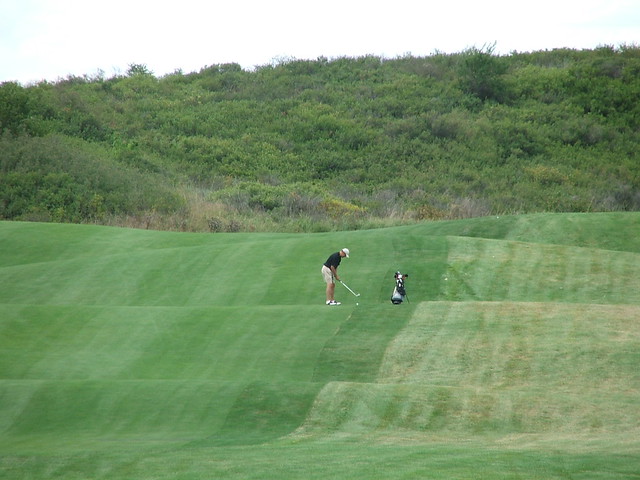
Two holes in particular are truly world class - the 8th hole, which is the #1 handicap hole is a 430 yard dogleg right that plays uphill all the way. The feature that makes it unique are the massive ripples in the fairway that look like waves coming in from the ocean. You can see in the pictures above, with a golfer present for perspective, how severe the slope and rippling both are.
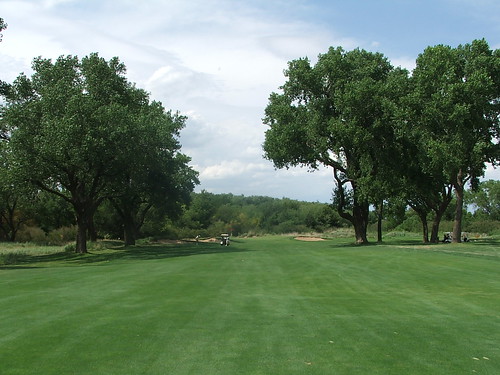
The 12th hole (pictured above) is a 390 yard par four and is also one of the best I've had the privilege to play. You hit your tee shot from an elevated tee to the fairway below. The strategy of the hole comes from two large cottonwood trees that are on either side of the fairway about 75 yards from the hole. These force you to either lay well back off the tee and then hit a high shot over them to the green or more typically to have to hit a low trajectory shot to a well protected and difficult green. It's too bad you don't see more holes like this. I guess this is because most golfers feel it is their right to have a clear shot at the green if they have a good drive in the fairway and architects generally agree. But I think this hole proves that there are exceptions (a very good exception in this case) to every rule. Also, in a stroke of brilliance, a really good drive hit precisely long enough and between the trees favoring the left side leaves an easy wedge shot between the trees. Great risk/reward!
I did some reading on Prairie Dunes prior to traveling to the course and was expecting the 10th hole to be a really exceptional hole. Maxwell himself said of the par three 10th hole - "this is the most beautiful par three ever constructed. Cypress Point, St. Andrews, Pinehurst and Augusta have nothing to compare with it." I don't agree with Mr. Maxwell on this point. The 10th is a fine golf hole but I actually thought that the 2nd (pictured below) and 4th hole, also par threes, were as good or better.
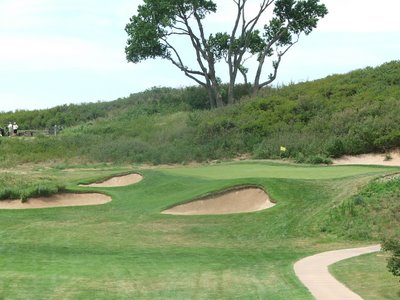

In an unfortunate incident at Prairie Dunes, on the 9th green the threesome riding behind us hit up on us while our threesome was on the green. Not just one golfer - all three players. For my regular readers you will know that I play fast - in fact we were playing at a good clip and most of the time were waiting for a twosome in front of us to move before we could hit. Being guests to the club we didn't make a big deal out of it. We let the assholes play through on the 10th tee. I'm not sure whether the three were just angry at living in a two-prison town or whether they had too much to drink, but this kind of behavior is not acceptable. God forbid they hit someone in the eye or the head with the ball - hitting up on people is a very bad idea. We mentioned the incident to the cart girl who was roaming the course with beverages. She said that this particular group has a reputation for hitting up on people while drinking. This is a commercial for not having a beverage cart circulate on a golf course, especially since this course had water on almost every tee box anyway. I'm sure most of the members of Prairie Dunes are delightful people but they should not tolerate this type of bad behavior. The cart girl apologized to us as did the assistant-pro whom she told as well. I don't see a place in golf for morons like these, though. If you would like to play through, all you have to do is ask. I hope the course has a good liability insurance policy in place while these guys remain members. Oh, and in what I think is complete poetic justice, to just prove the lack of intelligence of these fools, one drove out of the course after the round in a Hummer. In any event, I don't want to end on a negative, the place is great.
Kudos to the superintendents and green staff at both courses, which were in great condition. Prairie Dunes is a private club and access to play the course is through a member. You can visit their website for more history. The same for Southern Hills which will play host to the 2007 PGA Championship.



